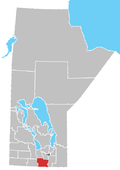Rural Municipality of Stanley
Rural Municipality of Stanley | |
|---|---|
 Location of the RM of Stanley in Manitoba | |
| Coordinates: 49°07′59″N 98°03′56″W / 49.13306°N 98.06556°W / 49.13306; -98.06556 | |
| Country | Canada |
| Province | Manitoba |
| Region | Pembina Valley |
| Established | 1890 |
| Government | |
| • Reeve | Ike Friesen |
| • Governing Body | RM of Stanley Council |
| • MP (Portage-Lisgar) | Branden Leslie |
| • MLA (Borderland) | Josh Guenter (PC) |
| Area | |
| • Total | 835.18 km2 (322.46 sq mi) |
| Population (2021) | |
| • Total | 8,981 |
| Time zone | UTC-6 (CST) |
| • Summer (DST) | UTC-5 (CDT) |
| Website | https://rmofstanley.ca |
Stanley is a rural municipality (RM) in the province of Manitoba in Western Canada. It is located in the southern part of the province, along its border with the state of North Dakota in the United States. Since 1876, the area made up part of the Mennonite West Reserve. The municipality has a population of 8,969 as of the 2016 Canada Census.[1] The cities of Winkler and Morden lie geographically within the municipality but are separate urban municipalities.
Etymology
The municipality is named for The Lord Stanley of Preston, 16th Earl of Derby, Governor General of Canada from 1888 to 1893, namesake for the Stanley Cup, which he donated.
Geography
According to Statistics Canada, the RM has an area of 835.59 km2 (322.62 sq mi). This does not include the areas belonging to the cities of Winkler and Morden, which are surrounded by the RM, in its north-eastern and northern sections, respectively.
Communities
- Blumenfeld
- Chortitz
- Friedensfeld
- Friedensruh
- Haskett
- Hochfeld
- Reinfeld
- Reinland
- Schanzenfeld
- Thornhill
- Neuenburg
Adjacent rural municipalities and counties
- Municipality of Pembina - (west)
- Rural Municipality of Thompson - (northwest)
- Rural Municipality of Roland - (northeast)
- Municipality of Rhineland - (east)
- Pembina County, North Dakota - (southeast)
- Cavalier County, North Dakota - (south)
Demographics
In the 2021 Census of Population conducted by Statistics Canada, Stanley had a population of 8,981 living in 2,279 of its 2,354 total private dwellings, a change of 0.1% from its 2016 population of 8,969. With a land area of 835.18 km2 (322.46 sq mi), it had a population density of 10.8/km2 (27.9/sq mi) in 2021.[2]
|
| |||||||||||||||||||||||||||||||||||||||||||||||||||||||||||||||||||||
| ||||||||||||||||||||||||||||||||||||||||||||||||||||||||||||||||||||||
| Panethnic group | 2021[4] | 2016[5] | 2011[6] | 2006[7] | 2001[8] | |||||
|---|---|---|---|---|---|---|---|---|---|---|
| Pop. | % | Pop. | % | Pop. | % | Pop. | % | Pop. | % | |
| European[a] | 8,690 | 97.15% | 8,830 | 97.89% | 8,270 | 99.28% | 6,320 | 99.22% | 5,130 | 99.81% |
| Indigenous | 165 | 1.84% | 135 | 1.5% | 20 | 0.24% | 10 | 0.16% | 10 | 0.19% |
| Latin American | 50 | 0.56% | 10 | 0.11% | 40 | 0.48% | 25 | 0.39% | 0 | 0% |
| African | 25 | 0.28% | 10 | 0.11% | 0 | 0% | 10 | 0.16% | 0 | 0% |
| East Asian[b] | 0 | 0% | 20 | 0.22% | 0 | 0% | 10 | 0.16% | 0 | 0% |
| Middle Eastern[c] | 0 | 0% | 20 | 0.22% | 0 | 0% | 0 | 0% | 0 | 0% |
| South Asian | 0 | 0% | 0 | 0% | 0 | 0% | 0 | 0% | 0 | 0% |
| Southeast Asian[d] | 0 | 0% | 0 | 0% | 0 | 0% | 0 | 0% | 0 | 0% |
| Other/multiracial[e] | 0 | 0% | 0 | 0% | 0 | 0% | 0 | 0% | 0 | 0% |
| Total responses | 8,945 | 99.6% | 9,020 | 100.57% | 8,330 | 99.69% | 6,370 | 100.05% | 5,140 | 100.35% |
| Total population | 8,981 | 100% | 8,969 | 100% | 8,356 | 100% | 6,367 | 100% | 5,122 | 100% |
| Note: Totals greater than 100% due to multiple origin responses | ||||||||||
See also
External links
- Official website
- Map of Stanley R.M. at Statcan
Notes
- ^ Statistic includes all persons that did not make up part of a visible minority or an indigenous identity.
- ^ Statistic includes total responses of "Chinese", "Korean", and "Japanese" under visible minority section on census.
- ^ Statistic includes total responses of "West Asian" and "Arab" under visible minority section on census.
- ^ Statistic includes total responses of "Filipino" and "Southeast Asian" under visible minority section on census.
- ^ Statistic includes total responses of "Visible minority, n.i.e." and "Multiple visible minorities" under visible minority section on census.
References
- ^ "Population and dwelling count amendments, 2016 Census". Statistics Canada. Retrieved July 25, 2021.
- ^ "Population and dwelling counts: Canada, provinces and territories, and census subdivisions (municipalities), Manitoba". Statistics Canada. February 9, 2022. Retrieved February 20, 2022.
- ^ Goldsborough, Gordon (June 15, 2022). "Manitoba Communities: Stanley(Rural Municipality)". Manitoba Historical Society. Retrieved July 20, 2022.
- ^ Government of Canada, Statistics Canada (October 26, 2022). "Census Profile, 2021 Census of Population". www12.statcan.gc.ca. Retrieved June 16, 2023.
- ^ Government of Canada, Statistics Canada (October 27, 2021). "Census Profile, 2016 Census". www12.statcan.gc.ca. Retrieved June 16, 2023.
- ^ Government of Canada, Statistics Canada (November 27, 2015). "NHS Profile". www12.statcan.gc.ca. Retrieved June 16, 2023.
- ^ Government of Canada, Statistics Canada (August 20, 2019). "2006 Community Profiles". www12.statcan.gc.ca. Retrieved June 16, 2023.
- ^ Government of Canada, Statistics Canada (July 2, 2019). "2001 Community Profiles". www12.statcan.gc.ca. Retrieved June 16, 2023.
